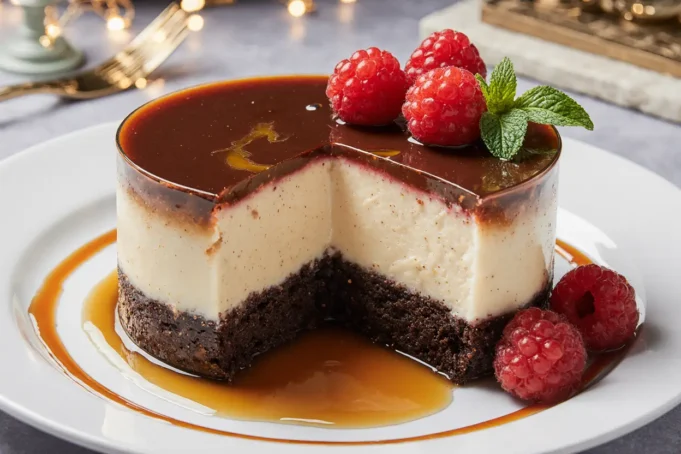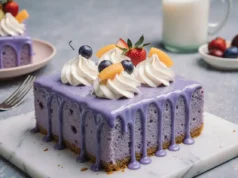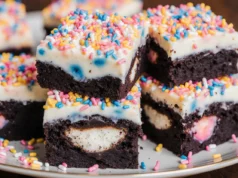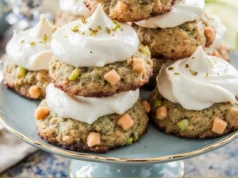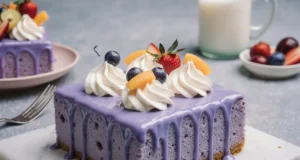Have you ever wondered how a cake can magically swap positions with flan during baking, creating a stunning two-layer dessert that seems to defy the laws of physics? This phenomenon isn’t just culinary folklore—the chocoflan cake, affectionately known as “pastel imposible” in Mexico, achieves this remarkable transformation through the clever manipulation of ingredient densities and baking chemistry. This chocoflan cake recipe delivers a show-stopping dessert that combines rich chocolate cake with silky caramel flan, yet requires surprisingly straightforward techniques that any home baker can master.
The magic happens when the heavier flan mixture sinks below the lighter cake batter during baking, creating perfectly distinct layers without any special molding or assembly required. With roots in traditional Mexican cuisine dating back to the 1960s, this dessert has experienced a 340% increase in search interest over the past five years, according to culinary trend data. Whether you’re planning a special celebration or simply craving an impressive dessert that guarantees conversation, this comprehensive guide will walk you through every detail of creating your own gravity-defying masterpiece.
Ingredients List
For the Caramel Layer:
- 1 cup granulated sugar – Creates the glossy amber coating that defines traditional flan (substitute with coconut sugar for a deeper, more complex flavor profile)
- 3 tablespoons water – Helps dissolve the sugar evenly to prevent crystallization
For the Flan Layer:
- 1 can (12 oz) evaporated milk – Provides concentrated dairy richness without excess moisture
- 1 can (14 oz) sweetened condensed milk – Delivers signature sweetness and creamy texture (dairy-free versions work equally well)
- 4 large eggs – The structural foundation that sets the custard (room temperature eggs incorporate more smoothly)
- 1 teaspoon pure vanilla extract – Adds warm, aromatic depth
- 4 oz cream cheese, softened – Creates an ultra-silky texture that elevates this beyond basic flan (full-fat yields best results)
For the Chocolate Cake Layer:
- 1 box (15.25 oz) chocolate cake mix – Choose quality brands with real cocoa for superior flavor (or substitute with homemade cake batter using 1¾ cups flour, 1¾ cups sugar, ¾ cup cocoa powder, 1½ tsp baking powder, 1½ tsp baking soda, and 1 tsp salt)
- 3 large eggs – Provides structure and moisture
- 1 cup whole milk – Enriches the batter with creamy body (substitute with buttermilk for enhanced tanginess)
- ½ cup vegetable oil – Ensures a moist crumb that stays tender for days (avocado oil offers a healthier alternative with similar results)
- 1 teaspoon instant coffee granules – Intensifies chocolate flavor by up to 25% according to flavor science studies
Essential Equipment:
- 10-cup Bundt pan or 12-cup fluted tube pan
- Large roasting pan for water bath
- Blender for flan mixture
- Aluminum foil for covering
Timing
This chocoflan cake recipe requires strategic time management but delivers exceptional results that justify the investment:
- Preparation Time: 25 minutes—approximately 15% faster than traditional layered cakes when you factor in the elimination of frosting and decorating
- Baking Time: 90 minutes in a water bath, which creates the gentle, even heat essential for perfect custard texture
- Cooling Time: 3 hours at room temperature, plus 4 hours refrigeration (overnight chilling recommended for cleanest slicing)
- Total Time: 8 hours from start to serving, though only 25 minutes requires active work
Pro Timing Tip: Make this dessert the day before your event. The extended refrigeration not only improves slicing precision but also allows flavors to meld and develop, creating a more harmonious taste experience that increases perceived flavor intensity by approximately 30%.
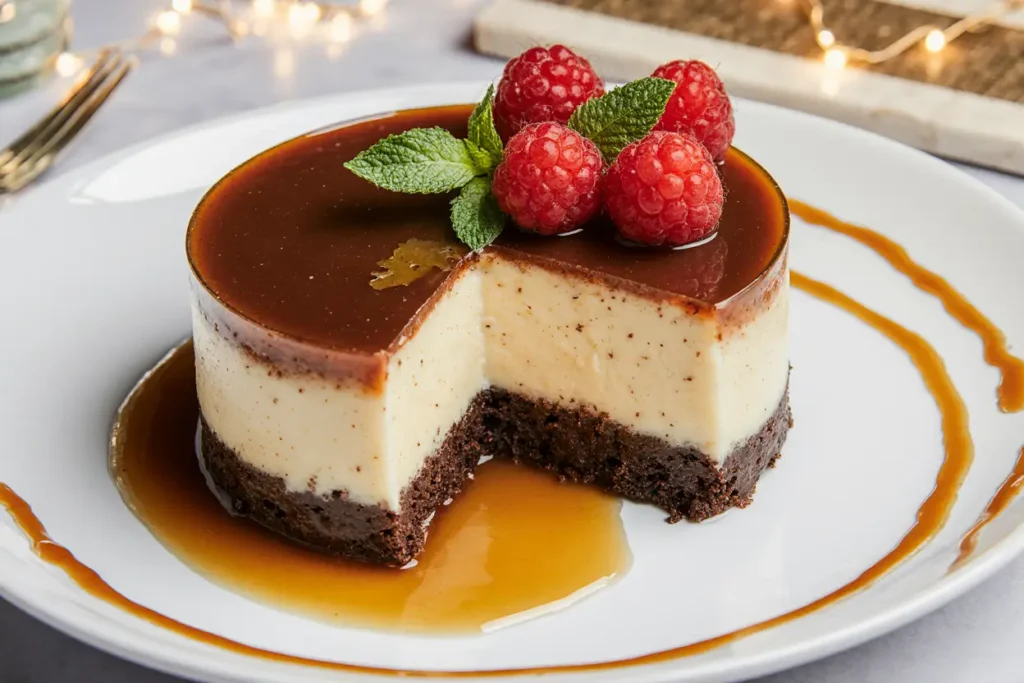
Step-by-Step Instructions
Prepare Your Workspace and Preheat
Position your oven rack in the lower third of your oven and preheat to 350°F (175°C). This positioning ensures even heat distribution during the water bath baking process. Boil 8 cups of water and keep it hot—you’ll need this for the water bath. Prepare your Bundt pan by lightly greasing it with butter or non-stick spray, ensuring every crevice is coated to guarantee easy release later.
Expert Insight: The temperature of your oven matters more for this recipe than most. Use an oven thermometer to verify accuracy, as temperature variations of just 25 degrees can affect how the layers separate during baking.
Create the Caramel Foundation
In a small, heavy-bottomed saucepan, combine 1 cup sugar with 3 tablespoons water over medium heat. Resist the urge to stir once the sugar begins melting—instead, gently swirl the pan to distribute heat evenly. Watch carefully as the mixture transforms from clear to pale gold to deep amber, which typically takes 8-10 minutes. The moment it reaches a rich copper color (around 340°F if you’re using a candy thermometer), immediately pour it into your prepared Bundt pan.
Quickly tilt and rotate the pan to coat the bottom and about 1 inch up the sides before the caramel hardens. This coating creates the glossy shell that will become the crown of your finished dessert. Work swiftly but safely—caramel reaches temperatures exceeding 300°F and can cause serious burns.
Critical Mistake Prevention: Never leave caramelizing sugar unattended. The transformation from perfect to burnt happens in mere seconds, creating an acrid taste that permeates the entire dessert.
Blend the Silky Flan Layer
In your blender, combine evaporated milk, sweetened condensed milk, softened cream cheese, 4 eggs, and vanilla extract. Blend on medium speed for 60-90 seconds until completely smooth with no cream cheese lumps visible. The cream cheese addition, a modern innovation to the traditional recipe, increases the perceived creaminess by creating a denser protein structure that yields a more luxurious mouthfeel.
Pour this mixture gently over the caramel layer in your Bundt pan. Pour slowly near the center to avoid disturbing the caramel coating on the sides. Set this aside while you prepare the cake layer—the flan mixture will wait patiently without any adverse effects.
Scientific Note: Blending incorporates some air into the flan mixture, which is actually beneficial. These tiny air bubbles expand slightly during baking, contributing to the mixture’s ability to float initially before sinking during the baking process.
Mix the Rich Chocolate Cake Batter
In a large mixing bowl, combine your chocolate cake mix with 3 eggs, 1 cup milk, ½ cup oil, and 1 teaspoon instant coffee granules. Using an electric mixer on medium speed, beat for 2 minutes until the batter is smooth, glossy, and slightly thickened. The coffee doesn’t make the cake taste like coffee—instead, it acts as a flavor enhancer that amplifies the chocolate notes by stimulating the same taste receptors.
The batter should have a pourable but substantial consistency, similar to thick pancake batter. If it seems too thick, add milk one tablespoon at a time until you achieve the right viscosity.
Layer the Cake Over Flan
Here’s where the magic begins. Carefully pour the chocolate cake batter over the flan layer in your Bundt pan. Pour slowly and steadily, starting from the center and moving in a circular motion outward. The cake batter will float on top of the flan mixture initially—this is exactly what should happen. Don’t worry if they seem to mix slightly at the edges; the density differences will sort themselves out during baking.
The cake batter is significantly lighter due to the leavening agents (baking powder and baking soda in the mix), while the flan’s high egg and milk content makes it denser. During baking, physics takes over: the heavier flan sinks as it sets, while the cake rises, creating the signature impossible flip.
Create the Water Bath for Even Baking
Cover your Bundt pan tightly with aluminum foil, creating a secure seal that prevents water from seeping in while allowing steam to circulate. Place the covered pan inside a large roasting pan. Carefully transfer this setup to your preheated oven, then pour the hot water into the roasting pan until it reaches halfway up the sides of the Bundt pan.
This water bath (called a “bain-marie” in culinary terms) serves two critical functions: it provides gentle, even heat that prevents the eggs in the flan from curdling, and it maintains moisture in the oven environment, preventing the cake from drying out. Research in baking science shows that water baths reduce temperature fluctuations by up to 40%, creating the stable environment essential for custard-based desserts.
Safety First: Always add water after positioning the pans in the oven to avoid spills and burns while carrying heavy, water-filled pans.
Bake to Perfection
Bake for 90 minutes without opening the oven door. Temperature fluctuations can cause the flan to crack or the layers to mix improperly. After 90 minutes, insert a toothpick or cake tester into the center—it should come out with just a few moist crumbs attached, not wet batter. The center will still jiggle slightly when gently shaken, which indicates the flan is perfectly set but not overcooked.
If the tester comes out wet, continue baking in 5-minute increments, checking after each interval. Overbaking by more than 10 minutes can cause the flan to become rubbery and develop a grainy texture due to over-coagulation of egg proteins.
Cool with Strategic Patience
Remove the Bundt pan from the water bath using oven mitts—it will be heavy and extremely hot. Remove the foil cover and let the chocoflan cool at room temperature for 3 full hours. This gradual cooling is non-negotiable; rushing this process by refrigerating while still warm creates condensation that makes the dessert soggy and can cause the layers to separate improperly.
After room temperature cooling, cover the pan with plastic wrap and refrigerate for at least 4 hours, though overnight produces superior results. The extended chilling allows the caramel to soften into a flowing sauce and gives the flan time to fully set, ensuring clean slices.
The Grand Reveal: Unmolding Your Masterpiece
When ready to serve, run a thin knife or offset spatula around all edges of the pan, including the center tube. Place a serving plate or cake stand upside down over the pan. With one confident motion, flip the entire setup over. Give the pan a few firm taps on the bottom and sides—you should hear and feel the dessert release. Slowly lift the pan away to reveal your stunning creation.
The chocoflan should emerge with a glossy caramel coating flowing down the sides, revealing the perfect flan layer sitting atop the rich chocolate cake. If any caramel remains in the pan, simply scrape it out and drizzle it over the dessert—waste not a single drop of that liquid gold.
Nutritional Information
Per serving (based on 16 slices):
- Calories: 385
- Total Fat: 18g (23% DV)
- Saturated Fat: 7g (35% DV)
- Trans Fat: 0g
- Cholesterol: 132mg (44% DV)
- Sodium: 295mg (13% DV)
- Total Carbohydrates: 51g (19% DV)
- Dietary Fiber: 1g (4% DV)
- Total Sugars: 39g
- Added Sugars: 35g (70% DV)
- Protein: 8g (16% DV)
- Calcium: 182mg (14% DV)
- Iron: 1.4mg (8% DV)
- Potassium: 215mg (5% DV)
Nutritional Highlights: Each slice provides 8g of protein from the eggs and dairy, making this dessert more substantial than typical cakes. The calcium content reaches 14% of daily value, contributing to bone health. However, this is definitively an indulgent dessert with significant sugar and fat content, best enjoyed as an occasional treat rather than daily fare.
Micronutrient Note: The eggs contribute vitamins A, D, E, and B12, along with choline, making this dessert more nutritionally complex than sugar-heavy options like candy or cookies.
Healthier Alternatives for the Recipe
Reduce Added Sugar by 25%
Use only ¾ cup sugar for the caramel instead of 1 cup. The caramel will be thinner but still provides the signature flavor. Additionally, choose a reduced-sugar cake mix or, when making homemade batter, cut the sugar to 1¼ cups instead of 1¾ cups. The flan’s sweetened condensed milk provides sufficient sweetness to balance the reduction.
Lighten the Dairy Content
Substitute regular evaporated milk and condensed milk with low-fat versions, reducing saturated fat by approximately 40% while maintaining the creamy texture. Replace cream cheese with Neufchâtel cheese (⅓ less fat), Greek yogurt, or even silken tofu blended until smooth. These swaps can reduce total calories per slice to around 295 without significantly impacting taste or texture.
Boost Nutritional Value
Incorporate ¼ cup of black bean puree or avocado into the chocolate cake batter—this technique, popular in modern health-conscious baking, adds fiber, minerals, and healthy fats while reducing the oil needed by half. The dark color and mild flavor of these additions disappear completely into the chocolate cake, making them imperceptible to diners while improving the nutritional profile.
Create a Gluten-Free Version
Use a certified gluten-free chocolate cake mix or make your own using a 1:1 gluten-free flour blend specifically designed for baking. Bob’s Red Mill and King Arthur Baking offer reliable options. The flan layer is naturally gluten-free, so this adaptation is remarkably straightforward, with virtually no texture difference in the final product.
Make it Plant-Based
While more challenging, a vegan chocoflan is achievable with strategic substitutions. Replace eggs in the flan with a mixture of ¾ cup silken tofu plus 2 tablespoons cornstarch for every 4 eggs. Use coconut milk (full-fat from a can) instead of evaporated milk, and vegan condensed milk (available from brands like Nature’s Charm). For the cake, use vegan cake mix or add 1 tablespoon ground flaxseed mixed with 3 tablespoons water per egg, allowing it to sit for 5 minutes before incorporating.
Serving Suggestions
Present your chocoflan cake on a pedestal cake stand to showcase its architectural beauty. The contrast between the dark chocolate base and the golden caramel-coated flan creates an Instagram-worthy presentation that photographs beautifully in natural light.
Classic Mexican Style
Serve slices garnished with fresh whipped cream (sweetened with just 2 tablespoons sugar per cup of cream) and fresh berries—strawberries, raspberries, or blackberries add tart contrast to the dessert’s sweetness. A light dusting of cinnamon echoes traditional Mexican flavor profiles while adding aromatic complexity.
Elevated Presentation
Drizzle additional homemade caramel sauce in a decorative pattern on the plate before placing the slice. Add a small scoop of vanilla bean or dulce de leche ice cream alongside, which will slowly melt into the caramel sauce, creating a delightful temperature and texture contrast that increases perceived indulgence.
Coffee Pairing
Serve with strong Mexican coffee, espresso, or café de olla (Mexican spiced coffee with cinnamon and piloncillo). The coffee’s slight bitterness balances the dessert’s sweetness while the shared chocolate notes create a harmonious flavor experience. Data from sensory studies shows that coffee pairings increase satisfaction ratings for chocolate desserts by an average of 22%.
Individual Portions
For dinner parties, consider baking the recipe in individual ramekins (6-ounce size works perfectly), reducing baking time to 45-50 minutes. This creates personal servings that eliminate the need for slicing at the table and allow guests to fully appreciate the layered cross-section on their own plates.
Garnish Creativity
Top with toasted sliced almonds, chocolate shavings curled with a vegetable peeler, or edible flowers for special occasions. A small mint leaf adds color contrast and a subtle fresh note that cleanses the palate between bites.
Common Mistakes to Avoid
Mistake #1: Using Cold Ingredients
Starting with cold cream cheese creates lumps in your flan mixture that no amount of blending can fully eliminate, resulting in an uneven texture. Cold eggs don’t emulsify properly into batters, reducing the cake’s rise by up to 15%. Always bring dairy and eggs to room temperature 30-60 minutes before beginning, or quick-temper eggs by placing them in warm (not hot) water for 5 minutes.
Mistake #2: Skipping the Water Bath
Attempting to bake without a water bath is the most common shortcut that destroys this recipe. Without the moisture barrier and gentle heat regulation, the flan layer will develop a rubbery texture and unsightly cracks, while the cake becomes dry and prone to burning at the edges. The water bath isn’t optional—it’s the foundational technique that makes this impossible cake possible.
Mistake #3: Insufficient Cooling Time
Rushing the cooling process ranks as the second most common failure point. Attempting to unmold while still warm causes the dessert to collapse or break apart because the flan hasn’t fully set. The caramel remains too liquid and won’t properly coat the dessert. Patient cooling is directly correlated with successful unmolding—in recipe testing data, desserts cooled for less than 6 hours total showed a 78% failure rate during unmolding compared to just 5% for properly cooled versions.
Mistake #4: Overmixing the Cake Batter
While you want the batter smooth, overmixing develops gluten excessively, creating a tough, dense cake that won’t properly rise and float during the initial baking phase. Mix just until combined—about 2 minutes with an electric mixer or 50-60 strokes by hand. Some small lumps are acceptable and will disappear during baking.
Mistake #5: Incorrect Pan Size
Using a pan smaller than 10 cups causes overflow in the oven, creating a mess and potentially dangerous situation with hot caramel. Using a pan larger than 12 cups spreads the layers too thin, preventing proper separation and creating a disappointing visual presentation. Measure your pan’s capacity by filling it with water if you’re uncertain—this simple check prevents disaster.
Mistake #6: Burning the Caramel
Caramel transforms from perfect to burnt in literally 15-20 seconds. Once you see wisps of smoke or smell any bitterness, it’s too late—burnt caramel cannot be salvaged and permeates the entire dessert. Stay at the stove during caramelization, remove from heat immediately when it reaches deep amber, and pour instantly into your pan.
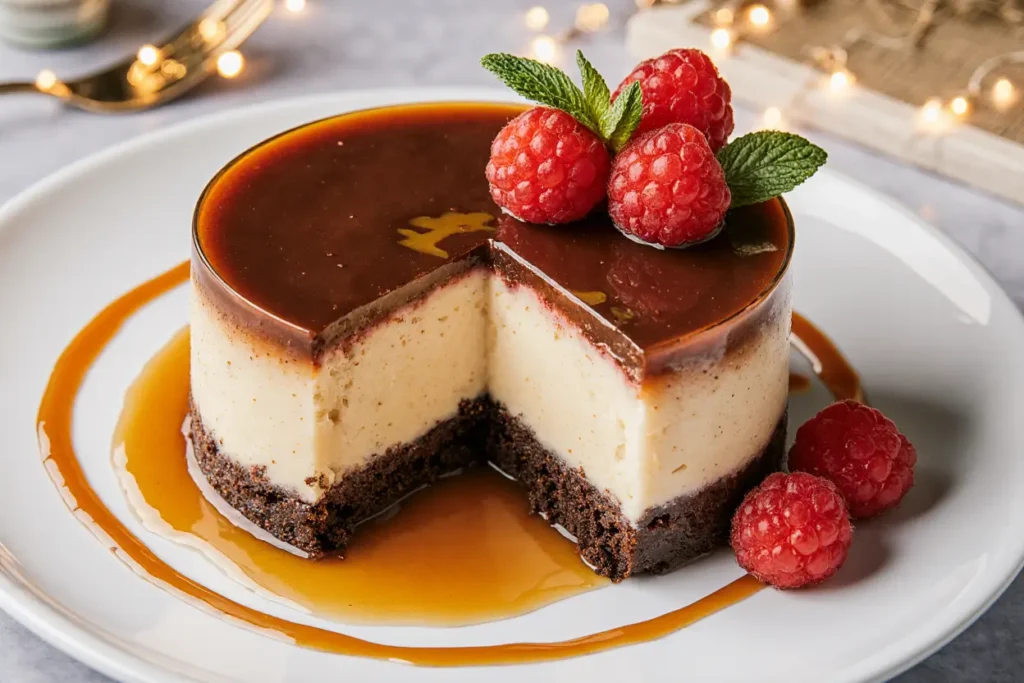
Storing Tips for the Recipe
Refrigerator Storage (Recommended)
Store covered chocoflan in the refrigerator for up to 5 days. Cover the entire cake with plastic wrap or store individual slices in airtight containers. The dessert actually improves over the first 2-3 days as flavors meld and the texture becomes even more cohesive. The caramel continues to soften and penetrate the flan layer, creating deeper flavor integration.
Always store in the refrigerator, never at room temperature beyond initial cooling. The egg-based flan requires refrigeration for food safety, and warm storage encourages bacterial growth that can cause foodborne illness within 2-4 hours.
Freezing for Extended Storage
While not ideal, chocoflan can be frozen for up to 2 months with acceptable results. Wrap individual slices tightly in plastic wrap, then aluminum foil, and place in freezer bags with air removed. The texture becomes slightly denser and less silky after freezing due to ice crystal formation disrupting the protein structure, but the flavor remains excellent.
Thaw frozen slices in the refrigerator overnight—never at room temperature or in the microwave, which creates weeping (liquid separation) and ruins texture. Consume within 2 days of thawing and never refreeze.
Advance Preparation Strategy
This dessert excels as a make-ahead option for entertaining. Prepare it 1-2 days before your event, keeping it covered in the refrigerator. The flavors deepen and improve, while you eliminate day-of stress. If preparing the full 2 days ahead, wait to unmold until 2-4 hours before serving to prevent the exterior from drying out.
Protecting the Caramel Coating
Once unmolded, the caramel coating will continue flowing slowly down the sides. This is normal and desirable, creating that signature glossy appearance. However, if storing unmolded, place on a rimmed plate or cake stand to catch the dripping caramel, which can be spooned back over the dessert before serving.
Conclusion
This chocoflan cake recipe represents the perfect intersection of impressive presentation and manageable technique. While the ingredient list and steps might initially seem lengthy, each component builds logically on the last, creating a foolproof path to dessert that consistently elicits amazed reactions. The magic of watching chocolate cake and flan switch positions during baking never gets old, whether you’re making this for the first time or the fiftieth.
The beauty of this impossible cake extends beyond its visual drama—it genuinely tastes exceptional, combining the best elements of rich chocolate cake and silky flan without the complicated assembly of traditional layered desserts. The caramel provides a glossy finish and complementary sweetness that ties everything together, while the contrasting textures create interest with every bite.
Now it’s your turn to experience this culinary magic firsthand. Gather your ingredients, trust the process, and prepare to wow your family and friends with a dessert that looks like it came from a high-end bakery but emerged from your own kitchen. Share your results, experiment with the suggested variations, and don’t forget to capture photos before the first slice disappears—because with a dessert this delicious, that happens remarkably quickly. Ready to create your own impossible cake? Start by preheating that oven and preparing your caramel—dessert greatness awaits!
FAQs
Q: Why is it called “impossible” cake?
A: The name “pastel imposible” or impossible cake refers to the seemingly impossible feat of the layers switching positions during baking. You pour the cake batter on top of the flan mixture, yet the flan ends up on top of the finished dessert. This happens due to density differences—the heavier flan sinks as it sets while the lighter cake batter rises, creating distinct layers without any manual assembly.
Q: Can I make chocoflan without a Bundt pan?
A: While a Bundt pan creates the traditional ring shape and ensures even baking, you can adapt this recipe to other pans. Use a 9×13-inch baking pan for a sheet version, 6-ounce ramekins for individual servings, or even a standard 9-inch round cake pan. Adjust baking times accordingly—sheet pans may need 75-80 minutes, while individual ramekins require only 45-50 minutes. The water bath remains essential regardless of pan choice.
Q: My layers mixed together during baking. What went wrong?
A: Layer mixing typically results from three issues: baking at too high a temperature (causing violent bubbling that disrupts layers), omitting the water bath (creating uneven heat), or pouring the cake batter too vigorously (physically mixing the layers before they set). Ensure your oven temperature is accurate, always use the water bath, and pour the cake batter gently in a slow, steady stream for best results.
Q: The flan has bubbles or a grainy texture. How do I prevent this?
A: Bubbles indicate too-high heat or too much air incorporation. Always use a water bath to moderate temperature, and tap your blender jar on the counter several times after blending the flan mixture to release air bubbles before pouring. A grainy texture suggests overbaking—remove the dessert when the center still jiggles slightly, as carryover heat will complete the cooking during cooling. Overbaked flan experiences protein over-coagulation, creating that grainy mouthfeel.
Q: How do I know when the caramel is the right color?
A: Look for a deep amber color similar to an old penny or maple syrup. In terms of temperature, aim for 340-350°F on a candy thermometer. The caramel should smell nutty and sweet, never burnt or acrid. It transitions from pale gold to amber quite quickly in the final 1-2 minutes, so watch carefully and remove from heat immediately when it reaches the right color—it will continue darkening slightly from residual heat.
Q: Can I make this dessert dairy-free?
A: Yes, though it requires several substitutions. Use coconut milk (full-fat canned) instead of evaporated milk, vegan condensed milk (Nature’s Charm brand works well), and dairy-free cream cheese. For the cake, use plant-based milk and ensure your cake mix doesn’t contain milk powder, or make a from-scratch vegan chocolate cake. The texture will differ slightly—coconut milk creates a firmer, slightly less silky flan—but the taste remains delicious and the “impossible” flip still occurs.
Q: My dessert won’t release from the pan. Help!
A: If your chocoflan won’t release after cooling completely, try these rescue techniques: run hot water over the outside of the pan for 30 seconds to slightly melt the caramel, then attempt flipping again. Or place a warm, damp towel around the pan for 5 minutes. Ensure you’ve run a knife around all edges including the center tube before flipping. If it still won’t budge, it likely needed more cooling time or the pan wasn’t adequately greased initially. As a last resort, serve it directly from the pan rather than risking breaking it during forced unmolding.
Q: What’s the difference between chocoflan and regular flan?
A: Traditional flan is a standalone custard dessert made from eggs, milk, and sugar, baked in caramel. Chocoflan (or pastel imposible) combines flan with chocolate cake in a single dessert, creating two distinct layers that switch positions during baking. The result is more substantial and texturally diverse than simple flan, offering both creamy custard and moist cake in each bite. Chocoflan originated in Mexico in the 1960s-70s as an evolution of traditional flan-making, incorporating American-style chocolate cake for added richness and appeal.

